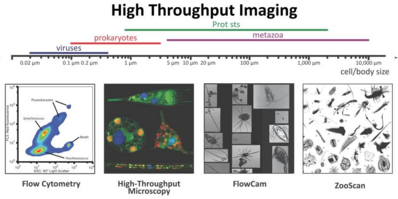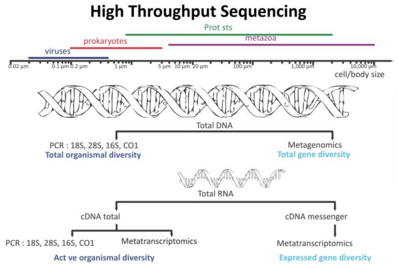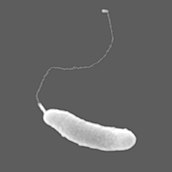Marine microorganisms
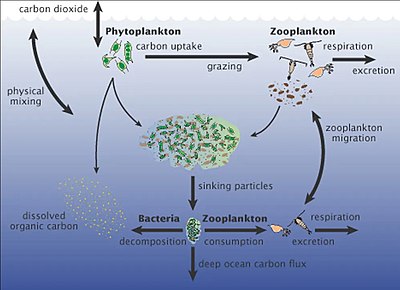
| Part of a series of overviews on |
| Marine life |
|---|
 |
| Part of a series on |
| Plankton |
|---|
 |
Marine microorganisms are defined by their habitat as
Marine microorganisms have been variously estimated to make up about 70%,
A small proportion of marine microorganisms are pathogenic, causing disease and even death in marine plants and animals.[9] However marine microorganisms recycle the major chemical elements, both producing and consuming about half of all organic matter generated on the planet every year. As inhabitants of the largest environment on Earth, microbial marine systems drive changes in every global system.
In July 2016, scientists reported identifying a set of 355 genes from the last universal common ancestor (LUCA) of all life on the planet, including the marine microorganisms.[10] Despite its diversity, microscopic life in the oceans is still poorly understood. For example, the role of viruses in marine ecosystems has barely been explored even in the beginning of the 21st century.[11]
Overview
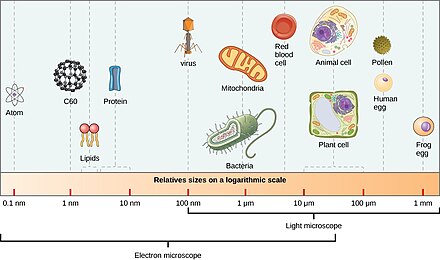
Microorganisms make up about 70% of the
Such organisms can be
Microorganisms are crucial to nutrient recycling in
| Marine microorganisms |
| |||||||||
While recent technological developments and scientific discoveries have been substantial, we still lack a major understanding at all levels of the basic ecological questions in relation to the microorganisms in our seas and oceans. These fundamental questions are:
1. What is out there? Which microorganisms are present in our seas and oceans and in what numbers do they occur?
2. What are they doing? What functions do each of these microorganisms perform in the marine environment and how do they contribute to the global cycles of energy and matter?
3. What are the factors that determine the presence or absence of a microorganism and how do they influence biodiversity and function and vice versa?
– European Science Foundation, 2012[12]: 14

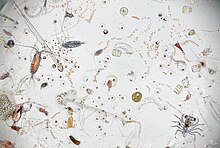
Microscopic life undersea is diverse and still poorly understood, such as for the role of viruses in marine ecosystems.[13] Most marine viruses are bacteriophages, which are harmless to plants and animals, but are essential to the regulation of saltwater and freshwater ecosystems.[14] They infect and destroy bacteria in aquatic microbial communities, and are the most important mechanism of recycling carbon in the marine environment. The organic molecules released from the dead bacterial cells stimulate fresh bacterial and algal growth.[15] Viral activity may also contribute to the biological pump, the process whereby carbon is sequestered in the deep ocean.[16]

A stream of airborne microorganisms circles the planet above weather systems but below commercial air lanes.[17] Some peripatetic microorganisms are swept up from terrestrial dust storms, but most originate from marine microorganisms in sea spray. In 2018, scientists reported that hundreds of millions of viruses and tens of millions of bacteria are deposited daily on every square meter around the planet.[18][19]
Microscopic organisms live throughout the
Marine viruses
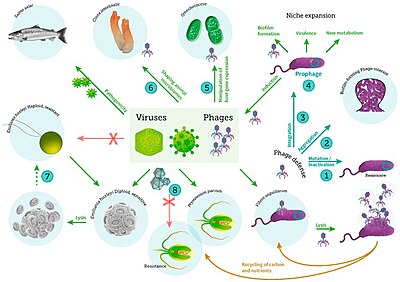
including viral infection of bacteria, phytoplankton and fish[30]
A
When not inside an infected cell or in the process of infecting a cell, viruses exist in the form of independent particles. These viral particles, also known as
The origins of viruses in the
Viruses are found wherever there is life and have probably existed since living cells first evolved.[35] The origin of viruses is unclear because they do not form fossils, so molecular techniques have been used to compare the DNA or RNA of viruses and are a useful means of investigating how they arose.[36]
Viruses are now recognised as ancient and as having origins that pre-date the divergence of life into the three domains.[37]
Opinions differ on whether viruses are a form of life or organic structures that interact with living organisms.[34] They are considered by some to be a life form, because they carry genetic material, reproduce by creating multiple copies of themselves through self-assembly, and evolve through natural selection. However they lack key characteristics such as a cellular structure generally considered necessary to count as life. Because they possess some but not all such qualities, viruses have been described as replicators[34] and as "organisms at the edge of life".[33]
Phages

There are also archaean viruses which replicate within archaea: these are double-stranded DNA viruses with unusual and sometimes unique shapes.[51][52] These viruses have been studied in most detail in the thermophilic archaea, particularly the orders Sulfolobales and Thermoproteales.[53]
Role of viruses
Microorganisms make up about 70% of the marine biomass.[4] It is estimated viruses kill 20% of this biomass each day and that there are 15 times as many viruses in the oceans as there are bacteria and archaea. Viruses are the main agents responsible for the rapid destruction of harmful algal blooms,[40] which often kill other marine life.[54] The number of viruses in the oceans decreases further offshore and deeper into the water, where there are fewer host organisms.[16]
Viruses are an important natural means of
Giant viruses
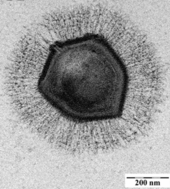
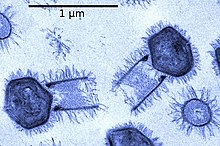
Viruses normally range in length from about 20 to 300 nanometers. This can be contrasted with the length of bacteria, which starts at about 400 nanometers. There are also giant viruses, often called giruses, typically about 1000 nanometers (one micron) in length. All giant viruses belongto phylum Nucleocytoviricota (NCLDV), together with poxviruses. The largest known of these is Tupanvirus. This genus of giant virus was discovered in 2018 in the deep ocean as well as a soda lake, and can reach up to 2.3 microns in total length.[56]
The discovery and subsequent characterization of giant viruses has triggered some debate concerning their evolutionary origins.[57] The two main hypotheses for their origin are that either they evolved from small viruses, picking up DNA from host organisms, or that they evolved from very complicated organisms into the current form which is not self-sufficient for reproduction.[58] What sort of complicated organism giant viruses might have diverged from is also a topic of debate. One proposal is that the origin point actually represents a fourth domain of life,[59][60] but this has been largely discounted.[61][62]
Prokaryotes
Marine bacteria
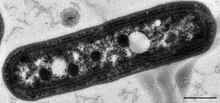
Once regarded as
The ancestors of modern bacteria were unicellular microorganisms that were the first forms of life to appear on Earth, about 4 billion years ago. For about 3 billion years, most organisms were microscopic, and bacteria and archaea were the dominant forms of life.[65][66] Although bacterial fossils exist, such as stromatolites, their lack of distinctive morphology prevents them from being used to examine the history of bacterial evolution, or to date the time of origin of a particular bacterial species. However, gene sequences can be used to reconstruct the bacterial phylogeny, and these studies indicate that bacteria diverged first from the archaeal/eukaryotic lineage.[67] Bacteria were also involved in the second great evolutionary divergence, that of the archaea and eukaryotes. Here, eukaryotes resulted from the entering of ancient bacteria into
-
The marine Thiomargarita namibiensis, largest known bacterium
-
Theendosymbiotic origin from cyanobacteria.[72]
-
The bacterium Marinomonas arctica grows inside Arctic sea ice at subzero temperatures
The largest known bacterium, the marine Thiomargarita namibiensis, can be visible to the naked eye and sometimes attains 0.75 mm (750 μm).[76][77]
Marine archaea
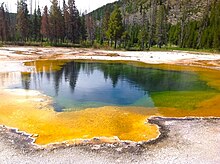
The
Archaea were initially classified as
Archaea and bacteria are generally similar in size and shape, although a few archaea have very strange shapes, such as the flat and square-shaped cells of
Archaea are particularly numerous in the oceans, and the archaea in plankton may be one of the most abundant groups of organisms on the planet. Archaea are a major part of Earth's life and may play roles in both the carbon cycle and the nitrogen cycle. Thermoproteota (also known as eocytes or Crenarchaeota) are a phylum of archaea thought to be very abundant in marine environments and one of the main contributors to the fixation of carbon.[82]
-
Eocytesmay be the most abundant of marine archaea
-
Halobacteria, found in water nearly saturated with salt, are now recognised as archaea.
-
Flat, square-shaped cells of the archaea Haloquadratum walsbyi
-
Methanosarcina barkeri, a marine archaea that produces methane
-
Thermophiles, such as Pyrolobus fumarii, survive well over 100 °C
Eukaryotes
All living organisms can be grouped as either prokaryotes or eukaryotes. Life originated as single-celled prokaryotes and later evolved into the more complex eukaryotes. In contrast to prokaryotic cells, eukaryotic cells are highly organised. Prokaryotes are the bacteria and archaea, while eukaryotes are the other life forms — protists, plants, fungi and animals. Protists are usually single-celled, while plants, fungi and animals are usually multi-celled.
It seems very plausible that the root of the eukaryotes lie within archaea; the closest relatives nowadays known may be the
Marine protists
By trophic mode
Protists can be broadly divided into four groups depending on whether their nutrition is plant-like, animal-like, fungal-like,[85] or a mixture of these.[86]
Protists according to how they get food
| |||||||
|---|---|---|---|---|---|---|---|
| Type of protist | Description | Example | Some other examples | ||||
| Plant-like | Autotrophic protists that make their own food without needing to consume other organisms, usually by using photosynthesis | 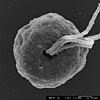
|
Green algae, Pyramimonas | Red and brown algae, diatoms and some dinoflagellates. Plant-like protists are important components of phytoplankton discussed below. | |||
| Animal-like | Protozoans |
Heterotrophic protists that get their food consuming other organisms (bacteria, archaea and small algae) | 
|
Radiolarian protist as drawn by Haeckel
|
amoebae, ciliates and flagellates .
| ||
| Fungal-like | slime nets |
Saprotrophic protists that get their food from the remains of organisms that have broken down and decayed
|

|
Marine slime nets form labyrinthine networks of tubes in which amoeba without pseudopods can travel
|
Marine lichen | ||
| Mixotrops | Various
|
osmotrophic protists that get their food from a combination of the above
|

|
Euglena mutabilis, a photosynthetic flagellate | Many marine mixotrops are found among protists, particularly among ciliates and dinoflagellates[87] | ||
Protists are highly diverse organisms currently organised into 18 phyla, but are not easy to classify.
- Single-celled and microscopic protists
-
Fossil diatom frustule from 32 to 40mya
-
Radiolarian
-
Single-celled alga, Gephyrocapsa oceanica
-
Two dinoflagellates
-
Euglenoid
-
Zooxanthellae is a photosynthetic algae that lives inside hosts like coral
-
A single-celledendosymbiotically
-
This ciliate is digesting cyanobacteria. The cytostome or mouth is at the bottom right.
| External videos | |
|---|---|
-
Ciliate ingesting a diatom
-
Amoeba engulfing a diatom
In contrast to the cells of prokaryotes, the cells of eukaryotes are highly organised. Plants, animals and fungi are usually
- Macroscopic protists (see also unicellular macroalgae)
-
The single-celledgiant amoeba has up to 1000 nucleiand reaches lengths of 5 mm
-
testate amoeba which makes mud trails. Its diameter is up to 3.8 cm.[96]
-
foraminiferan with an appearance and lifestyle that mimics a sponge, grows to 5 cm long.
-
Thexenophyophore, another single-celled foraminiferan, lives in abyssal zones. It has a giant shell up to 20 cm across.[97]
-
Giant kelp, a brown algae, is not a true plant, yet it is multicellular and can grow to 50m
Protists have been described as a taxonomic grab bag of misfits where anything that doesn't fit into one of the main biological kingdoms can be placed.[98] Some modern authors prefer to exclude multicellular organisms from the traditional definition of a protist, restricting protists to unicellular organisms.[99][100] This more constrained definition excludes many brown, multicellular red and green algae, and slime molds.[101]
By locomotion
Another way of categorising protists is according to their mode of locomotion. Many unicellular protists, particularly protozoans, are
Protists according to how they move
| ||||||||
|---|---|---|---|---|---|---|---|---|
| Type of protist | Movement mechanism | Description | Example | Other examples | ||||
| Motile | Flagellates | 
|
A flagellum (Latin for whip) is a lash-like appendage that protrudes from the cell body of some protists (as well as some bacteria). Flagellates use from one to several flagella for locomotion and sometimes as feeding and sensory organelle. | 
|
Cryptophytes | All foraminiferans and Apicomplexa )
| ||
| Ciliates | 
|
A cilium (Latin for eyelash) is a tiny flagellum. Ciliates use multiple cilia, which can number in many hundreds, to power themselves through the water. | 
|
Paramecium bursaria click to see cilia |
amoebae, ciliates and flagellates .
| |||
| Amoebas (amoeboids) |
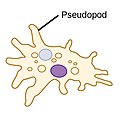
|
Amoeba have the ability to alter shape by extending and retracting pseudopods (Greek for false feet).[104] |  |
Amoeba | Found in every major protist | |||
| Not motile | none
|
 |
Diatom | Diatoms, coccolithophores, and non‐motile species of Phaeocystis[103] Among protozoans the parasitic Apicomplexa are non‐motile. | ||||
Flagellates include bacteria as well as protists. The rotary motor model used by bacteria uses the protons of an electrochemical gradient in order to move their flagella. Torque in the flagella of bacteria is created by particles that conduct protons around the base of the flagellum. The direction of rotation of the flagella in bacteria comes from the occupancy of the proton channels along the perimeter of the flagellar motor.[107]
Ciliates generally have hundreds to thousands of cilia that are densely packed together in arrays. During movement, an individual cilium deforms using a high-friction power stroke followed by a low-friction recovery stroke. Since there are multiple cilia packed together on an individual organism, they display collective behavior in a metachronal rhythm. This means the deformation of one cilium is in phase with the deformation of its neighbor, causing deformation waves that propagate along the surface of the organism. These propagating waves of cilia are what allow the organism to use the cilia in a coordinated manner to move. A typical example of a ciliated microorganism is the Paramecium, a one-celled, ciliated protozoan covered by thousands of cilia. The cilia beating together allow the Paramecium to propel through the water at speeds of 500 micrometers per second.[108]
| External videos | |
|---|---|
- Flagellate, ciliates and amoeba
-
Bacterial flagellum rotated by a molecular motor at its base
-
Salmonspermatozoa
-
The ciliateOxytricha trifallaxwith cilia clearly visible
-
Amoeba with ingested diatoms
Marine fungi

Over 1500 species of
A typical milliliter of seawater contains about 103 to 104 fungal cells.[119] This number is greater in coastal ecosystems and estuaries due to nutritional runoff from terrestrial communities. A higher diversity of mycoplankton is found around coasts and in surface waters down to 1000 metres, with a vertical profile that depends on how abundant phytoplankton is.[120][121] This profile changes between seasons due to changes in nutrient availability.[122] Marine fungi survive in a constant oxygen deficient environment, and therefore depend on oxygen diffusion by turbulence and oxygen generated by photosynthetic organisms.[123]
Marine fungi can be classified as:[123]
- Lower fungi – adapted to marine habitats (zoosporic fungi, including mastigomycetes: oomycetes and chytridiomycetes)
- Higher fungi – filamentous, modified to planktonic lifestyle (hyphomycetes, ascomycetes, basidiomycetes). Most mycoplankton species are higher fungi.[120]
The sea snail Littoraria irrorata damages plants of Spartina in the sea marshes where it lives, which enables spores of intertidal ascomycetous fungi to colonise the plant. The snail then eats the fungal growth in preference to the grass itself.[128]
According to fossil records, fungi date back to the late Proterozoic era 900-570 million years ago. Fossil marine lichens 600 million years old have been discovered in China.[129] It has been hypothesized that mycoplankton evolved from terrestrial fungi, likely in the Paleozoic era (390 million years ago).[130]
Marine microanimals
As juveniles, animals develop from microscopic stages, which can include
- Marine microanimals
-
Over 10,000 marine species are copepods, small, often microscopic crustaceans
-
Darkfield photo of a gastrotrich, 0.06-3.0 mm long, a worm-like animal living between sediment particles
-
Armoured Pliciloricus enigmaticus, about 0.2 mm long, live in spaces between marine gravel
-
Rotifers, usually 0.1–0.5 mm long, may look like protists but are multicellular and belong to the Animalia
-
Tardigrades (water bears), about 0.5 mm long, are among the most resilient animals known
Primary producers
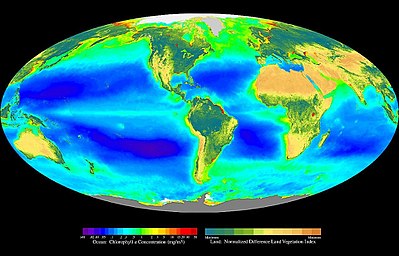
The principal marine primary producers are cyanobacteria, algae and marine plants. The oxygen released as a by-product of photosynthesis is needed by nearly all living things to carry out cellular respiration. In addition, primary producers are influential in the global carbon and water cycles. They stabilize coastal areas and can provide habitats for marine animals. The term division has been traditionally used instead of phylum when discussing primary producers, but the International Code of Nomenclature for algae, fungi, and plants now accepts both terms as equivalents.[134]
Cyanobacteria
| External videos | |
|---|---|
Cyanobacteria were the first organisms to evolve an ability to turn sunlight into chemical energy. They form a phylum (division) of bacteria which range from unicellular to filamentous and include colonial species. They are found almost everywhere on earth: in damp soil, in both freshwater and marine environments, and even on Antarctic rocks.[136] In particular, some species occur as drifting cells floating in the ocean, and as such were amongst the first of the phytoplankton.
The first primary producers that used photosynthesis were oceanic
The tiny (0.6
Originally, biologists thought
Algae
Dinoflagellates and diatoms are important components of marine algae and have their own sections below.
Not all algae are microscopic. Green, red and brown algae all have multicellular macroscopic forms that make up the familiar
Unicellular organisms are usually microscopic. There are exceptions.
-
Chlamydomonas globosa, a unicellular green alga with twoflagellajust visible at bottom left
-
Centric diatom
-
Dinoflagellates
-
Colonial algal chains
Marine microplankton
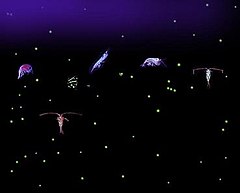
Plankton (from Greek for wanderers) are a diverse group of organisms that live in the water column of large bodies of water but cannot swim against a current. As a result, they wander or drift with the currents.[153] Plankton are defined by their ecological niche, not by any phylogenetic or taxonomic classification. They are a crucial source of food for many marine animals, from forage fish to whales. Plankton can be divided into a plant-like component and an animal component.
Phytoplankton
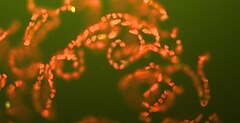
Phytoplankton perform three crucial functions: they generate nearly half of the world atmospheric oxygen, they regulate ocean and atmospheric carbon dioxide levels, and they form the base of the marine
Phytoplankton consist mainly of microscopic photosynthetic
- Phytoplankton
-
Phytoplankton are the foundation of the ocean food chain
-
They come in many shapes and sizes.
-
Colonial phytoplankton
-
The cyanobacterium Prochlorococcus accounts for much of the ocean's primary production
-
Green cyanobacteria scum washed up on a rock in California
Diatoms
Diatoms form a (disputed) phylum containing about 100,000 recognised species of mainly unicellular algae. Diatoms generate about 20 per cent of the oxygen produced on the planet each year,[93] take in over 6.7 billion metric tons of silicon each year from the waters in which they live,[159] and contribute nearly half of the organic material found in the oceans.
-
Diatoms are one of the most common types of phytoplankton
-
Their protective shells (frustles) are made of silicon
-
They come in many shapes and sizes
Diatoms are enclosed in protective silica (glass) shells called frustules. Each frustule is made from two interlocking parts covered with tiny holes through which the diatom exchanges nutrients and wastes.[156] The frustules of dead diatoms drift to the ocean floor where, over millions of years, they can build up as much as half a mile deep.[160]
-
Silicified frustule of a pennate diatom with two overlapping halves
-
Guinardia delicatula, a diatom responsible for algal blooms in the North Sea and the English Channel[161]
-
Fossil diatom
-
There are over 100,000 species of diatoms which account for 50% of the ocean's primary production
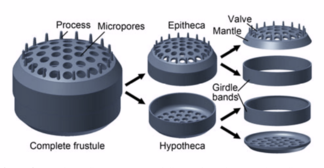
| External videos | |
|---|---|
Coccolithophores
Coccolithophores are minute unicellular photosynthetic protists with two flagella for locomotion. Most of them are protected by a shell covered with ornate circular plates or scales called coccoliths. The coccoliths are made from calcium carbonate. The calcite shells are important to the marine carbon cycle.[163] The term coccolithophore derives from the Greek for a seed carrying stone, referring to their small size and the coccolith stones they carry. Under the right conditions they bloom, like other phytoplankton, and can turn the ocean milky white.[164]
-
Coccolithophores have plates called coccoliths
-
Coccolithus pelagicus ssp. braarudii
-
Algae bloomof Emiliania huxleyi off the southern coast of England
-
Extinct fossil
Microbial rhodopsin
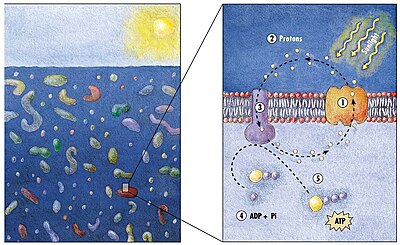
(2) it changes its configuration so a proton is expelled from the cell
(3) the chemical potential causes the proton to flow back to the cell
(4) thus generating energy
(5) in the form of adenosine triphosphate.[165]
Phototrophic metabolism relies on one of three energy-converting pigments: chlorophyll, bacteriochlorophyll, and retinal. Retinal is the chromophore found in rhodopsins. The significance of chlorophyll in converting light energy has been written about for decades, but phototrophy based on retinal pigments is just beginning to be studied.[166]
In 2000 a team of microbiologists led by Edward DeLong made a crucial discovery in the understanding of the marine carbon and energy cycles. They discovered a gene in several species of bacteria[168][169] responsible for production of the protein rhodopsin, previously unheard of in bacteria. These proteins found in the cell membranes are capable of converting light energy to biochemical energy due to a change in configuration of the rhodopsin molecule as sunlight strikes it, causing the pumping of a proton from inside out and a subsequent inflow that generates the energy.[170] The archaeal-like rhodopsins have subsequently been found among different taxa, protists as well as in bacteria and archaea, though they are rare in complex multicellular organisms.[171][172][173]
Research in 2019 shows these "sun-snatching bacteria" are more widespread than previously thought and could change how oceans are affected by global warming. "The findings break from the traditional interpretation of marine ecology found in textbooks, which states that nearly all sunlight in the ocean is captured by chlorophyll in algae. Instead, rhodopsin-equipped bacteria function like hybrid cars, powered by organic matter when available — as most bacteria are — and by sunlight when nutrients are scarce."[174][166]
There is an astrobiological conjecture called the Purple Earth hypothesis which surmises that original life forms on Earth were retinal-based rather than chlorophyll-based, which would have made the Earth appear purple instead of green.[175][176]
Redfield and f- ratios
During the 1930s Alfred C. Redfield found similarities between the composition of elements in phytoplankton and the major dissolved nutrients in the deep ocean.[177] Redfield proposed that the ratio of carbon to nitrogen to phosphorus (106:16:1) in the ocean was controlled by the phytoplankton's requirements, as phytoplankton subsequently release nitrogen and phosphorus as they remineralize. This ratio has become known as the Redfield ratio, and is used as a fundamental principle in describing the stoichiometry of seawater and phytoplankton evolution.[178]
However, the Redfield ratio is not a universal value and can change with things like geographical latitude.[179] Based on allocation of resources, phytoplankton can be classified into three different growth strategies: survivalist, bloomer and generalist. Survivalist phytoplankton has a high N:P ratio (>30) and contains an abundance of resource-acquisition machinery to sustain growth under scarce resources. Bloomer phytoplankton has a low N:P ratio (<10), contains a high proportion of growth machinery and is adapted to exponential growth. Generalist phytoplankton has similar N:P to the Redfield ratio and contain relatively equal resource-acquisition and growth machinery.[178]
The f-ratio is the fraction of total primary production fuelled by nitrate (as opposed to that fuelled by other nitrogen compounds such as ammonium). The ratio was originally defined by Richard Eppley and Bruce Peterson in one of the first papers estimating global oceanic production.[180]
Zooplankton
Zooplankton are generally larger than phytoplankton, mostly still microscopic but some can be seen with the naked eye. Many
.Microzooplankton: major grazers of the plankton...
Many species of
Radiolarians
-
Like diatoms, radiolarians come in many shapes
-
Also like diatoms, radiolarian shells are usually made of silicate
-
Howeveracantharian radiolarians have shells made from strontium sulfatecrystals
-
Cutaway schematic diagram of a spherical radiolarian shell
-
Cladococcus abietinus
| External videos | |
|---|---|
Foraminiferans
Like radiolarians, foraminiferans (forams for short) are single-celled predatory protists, also protected with shells that have holes in them. Their name comes from the Latin for "hole bearers". Their shells, often called tests, are chambered (forams add more chambers as they grow). The shells are usually made of calcite, but are sometimes made of agglutinated sediment particles or chiton, and (rarely) of silica. Most forams are benthic, but about 40 species are planktic.[187] They are widely researched with well established fossil records which allow scientists to infer a lot about past environments and climates.[185]
| External videos | |
|---|---|
-
section showing chambers of a spiral foram
-
Live Ammonia tepida streaming granular ectoplasm for catching food
-
Group of planktonic forams
-
Fossil nummulitid forams of various sizes from the Eocene
-
TheEgyptian pyramids were constructed from limestone that contained nummulites.[188]
A number of forams are mixotrophic (see below). These have unicellular algae as endosymbionts, from diverse lineages such as the green algae, red algae, golden algae, diatoms, and dinoflagellates.[187] Mixotrophic foraminifers are particularly common in nutrient-poor oceanic waters.[189] Some forams are kleptoplastic, retaining chloroplasts from ingested algae to conduct photosynthesis.[190]
Amoeba
- Shelled and naked amoeba
-
Testate amoeba, Cyphoderiasp.
-
Shell or test of atestate amoeba, Arcellasp.
-
Xenogenic testate amoeba covered in diatoms (from Penard's Amoeba Collection)
-
Naked amoeba, Chaos sp.
-
Naked amoeba showing food vacuoles and ingested diatom
Ciliates
-
Holophyra ovum
-
Mesodinium rubrum produce deep red blooms using enslaved chloroplasts from their algal prey [191]
-
Several taxa of ciliates interacting
-
Blepharisma americanum swimming in a drop of pond water with other microorganisms
Mixotrophs
A
The distinction between plants and animals often breaks down in very small organisms. Possible combinations are photo- and chemotrophy, litho- and organotrophy, auto- and heterotrophy or other combinations of these. Mixotrophs can be either eukaryotic or prokaryotic.[194] They can take advantage of different environmental conditions.[195]
Recent studies of marine microzooplankton found 30–45% of the ciliate abundance was mixotrophic, and up to 65% of the amoeboid, foram and radiolarian biomass was mixotrophic.[87]
Phaeocystis is an important algal genus found as part of the marine phytoplankton around the world. It has a polymorphic life cycle, ranging from free-living cells to large colonies.[196] It has the ability to form floating colonies, where hundreds of cells are embedded in a gel matrix, which can increase massively in size during blooms.[197] As a result, Phaeocystis is an important contributor to the marine carbon[198] and sulfur cycles.[199] Phaeocystis species are endosymbionts to acantharian radiolarians.[200][201]
Mixotrophic plankton that combine phototrophy and heterotrophy – table based on Stoecker et al., 2017[202]
| |||||||
|---|---|---|---|---|---|---|---|
| General types | Description | Example | Further examples | ||||
| Bacterioplankton | Photoheterotrophic bacterioplankton
|

|
Vibrio cholerae | Roseobacter spp. Erythrobacter spp. Gammaproteobacterial clade OM60 Widespread among bacteria and archaea | |||
| Phytoplankton | Called constitutive mixotrophs by Mitra et al., 2016.[203] Phytoplankton that eat: photosynthetic protists with inherited plastids and the capacity to ingest prey. | 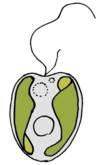
|
Ochromonas species | Prorocentrum minimum
| |||
| Zooplankton | Called nonconstitutive mixotrophs by Mitra et al., 2016.[203] Zooplankton that are photosynthetic: microzooplankton or metazoan zooplankton that acquire phototrophy through chloroplast retentiona or maintenance of algal endosymbionts. | ||||||
| Generalists | Protists that retain chloroplasts and rarely other organelles from many algal taxa | 
|
Most oligotrich ciliates that retain plastidsa | ||||
| Specialists | 1. Protists that retain chloroplasts and sometimes other organelles from one algal species or very closely related algal species | 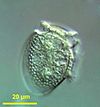
|
Dinophysis acuminata | Myrionecta rubra
| |||
| 2. Protists or zooplankton with algal endosymbionts of only one algal species or very closely related algal species | 
|
Noctiluca scintillans | |||||
| aChloroplast (or plastid) retention = sequestration = enslavement. Some plastid-retaining species also retain other organelles and prey cytoplasm. | |||||||
- Mixoplankton
-
Tintinnid ciliate Favella
-
Euglena mutabilis, a photosynthetic flagellate
-
Zoochlorellae (green) living inside the ciliateStichotricha secunda
Dinoflagellates
By trophic orientation dinoflagellates cannot be uniformly categorized. Some dinoflagellates are known to be
The toxic dinoflagellate
-
Gyrodinium, one of the few naked dinoflagellates which lack armour
-
The dinoflagellate Protoperidinium extrudes a large feeding veil to capture prey
-
Nassellarianradiolarians can be in symbiosis with dinoflagellates
-
The dinoflagellate Dinophysis acuta
Dinoflagellates often live in
Some dinoflagellates are
-
Tripos muelleri is recognisable by its U-shaped horns
-
velvet disease in fish[213]
-
Karenia brevis produces red tides highly toxic to humans[214]
-
Red tide
-
Noctiluca scintillans, a bioluminescent dinoflagellate[215]
Marine sediments and microfossils
Sediments at the bottom of the ocean have two main origins, terrigenous and biogenous.
Terrigenous sediments account for about 45% of the total marine sediment, and originate in the erosion of rocks on land, transported by rivers and land runoff, windborne dust, volcanoes, or grinding by glaciers.
Main types of biogenic ooze
| ||||||||
|---|---|---|---|---|---|---|---|---|
| type | mineral forms |
protist involved |
name of skeleton | typical size (mm) |
||||
| Siliceous ooze | diatom | 
|
frustule | 0.002 to 0.2[218] | 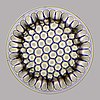
|
diatom microfossil from 40 million years ago | ||
radiolarian
|

|
test or shell | 0.1 to 0.2 | 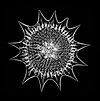
|
elaborate silica shell of a radiolarian | |||
Calcareous ooze
|
CaCO3 calcite aragonite limestone marble chalk |
foraminiferan
|

|
test or shell | < 1 | 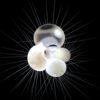
|
||
| coccolithophore | 
|
coccoliths | < 0.1[220] | 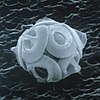
|
Coccolithophores are the largest global source of biogenic calcium carbonate, and significantly contribute to the global carbon cycle. white cliffs of Dover .
| |||
-
diatoms(click to magnify)
-
Calcareous microfossils from marine sediment consisting mainly of star-shaped discoaster with a sprinkling of coccoliths
-
Shells (tests), usually made of calcium carbonate, from a foraminiferal ooze on the deep ocean floor
-
Illustration of a Globigerina ooze
-
Opal can contain protist microfossils of diatoms, radiolarians, silicoflagellates and ebridians[222]
-
Distribution of sediment types on the seafloor
Within each colored area, the type of material shown is what dominates, although other materials are also likely to be present.
For further information, see here
Marine microbenthos
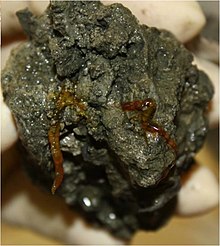
Marine microbenthos are microorganisms that live in the benthic zone of the ocean – that live near or on the seafloor, or within or on surface seafloor sediments. The word benthos comes from Greek, meaning "depth of the sea". Microbenthos are found everywhere on or about the seafloor of continental shelves, as well as in deeper waters, with greater diversity in or on seafloor sediments. In shallow waters, seagrass meadows, coral reefs and kelp forests provide particularly rich habitats. In photic zones benthic diatoms dominate as photosynthetic organisms. In intertidal zones changing tides strongly control opportunities for microbenthos.
-
Elphidium a widespread abundant genus of benthic forams
-
Heterohelix, an extinct genus of benthic forams
Both foraminifera and diatoms have
The sudden extinction event which killed the dinosaurs 66 million years ago also rendered extinct three-quarters of all other animal and plant species. However, deep-sea benthic forams flourished in the aftermath. In 2020 it was reported that researchers have examined the chemical composition of thousands of samples of these benthic forams and used their findings to build the most detailed climate record of Earth ever.[224][225]
Some endoliths have extremely long lives. In 2013 researchers reported evidence of endoliths in the ocean floor, perhaps millions of years old, with a generation time of 10,000 years.[226] These are slowly metabolizing and not in a dormant state. Some Actinomycetota found in Siberia are estimated to be half a million years old.[227][228][229]
Marine microbiomes
Symbiosis and holobionts
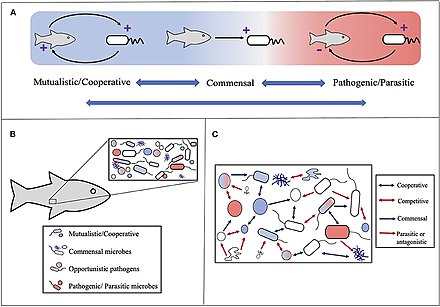
The concept of the holobiont was initially defined by Dr. Lynn Margulis in her 1991 book Symbiosis as a Source of Evolutionary Innovation as an assemblage of a host and the many other species living in or around it, which together form a discrete ecological unit.[231] The components of a holobiont are individual species or bionts, while the combined genome of all bionts is the hologenome.[232]
The concept has subsequently evolved since this original definition,[233] with the focus moving to the microbial species associated with the host. Thus the holobiont includes the host, virome, microbiome, and other members, all of which contribute in some way to the function of the whole.[234][235] A holobiont typically includes a eukaryote host and all of the symbiotic viruses, bacteria, fungi, etc. that live on or inside it.[236]
However, there is controversy over whether holobionts can be viewed as single evolutionary units.[237]
Reef-building corals are well-studied holobionts that include the coral itself (a eukaryotic invertebrate within class Anthozoa), photosynthetic dinoflagellates called zooxanthellae (Symbiodinium), and associated bacteria and viruses.[238] Co-evolutionary patterns exist for coral microbial communities and coral phylogeny.[239]
Marine food web
Marine microorganisms play central roles in the marine food web.
The

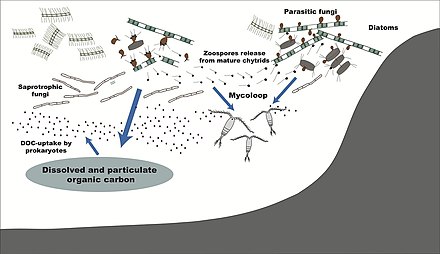
| External videos | |
|---|---|
-
Pelagibacter ubique, the most abundant bacteria in the ocean, plays a major role in the global carbon cycle.
-
Marine snow is the shower of organic particles that falls from upper waters to the deep ocean[248] It is a major exporter of carbon.

Niche communities
Sea ice microbial communities (SIMCO) refer to groups of microorganisms living within and at the interfaces of sea ice at the poles. The ice matrix they inhabit has strong vertical gradients of salinity, light, temperature and nutrients. Sea ice chemistry is most influenced by the salinity of the brine which affects the pH and the concentration of dissolved nutrients and gases. The brine formed during the melting sea ice creates pores and channels in the sea ice in which these microbes can live. As a result of these gradients and dynamic conditions, a higher abundance of microbes are found in the lower layer of the ice, although some are found in the middle and upper layers.[251]
Deep biosphere and dark matter
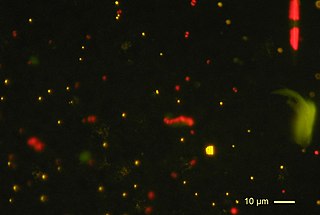
The deep biosphere is that part of the biosphere that resides below the first few meters of the surface. It extends at least 5 kilometers below the continental surface and 10.5 kilometers below the sea surface, with temperatures that may exceed 100 °C.
Above the surface living organisms consume organic matter and oxygen. Lower down, these are not available, so they make use of "edibles" (electron donors) such as hydrogen released from rocks by various chemical processes, methane, reduced sulfur compounds and ammonium. They "breathe" electron acceptors such as nitrates and nitrites, manganese and iron oxides, oxidized sulfur compounds and carbon dioxide.
There is very little energy at greater depths, and metabolism can be up to a million times slower than at the surface. Cells may live for thousands of years before dividing and there is no known limit to their age. The subsurface accounts for about 90% of the biomass in bacteria and archaea, and 15% of the total biomass for the biosphere. Eukaryotes are also found, mostly microscopic, but including some multicellular life. Viruses are also present and infect the microbes.
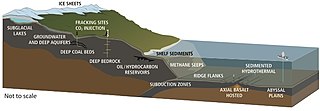
In 2018, researchers from the
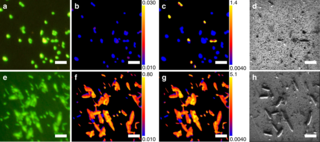
In 2020 researchers reported they had found what could be the longest-living life forms ever: aerobic microorganisms which had been in quasi-suspended animation for up to 101.5 million years. The microorganisms were found in organically poor sediments 68.9 metres (226 feet) below the seafloor in the South Pacific Gyre (SPG), "the deadest spot in the ocean".[269][270]
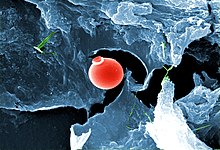
To date biologists have been unable to
Microbial diversity
-
Estimates of microbial species counts in the three domains of lifeBacteria are the oldest and most biodiverse group, followed by Archaea and Fungi (the most recent groups). In 1998, before awareness of the extent of microbial life had gotten underway,
-
Microbial diversityComparative representation of the known and estimated (small box) and the yet unknown (large box) microbial diversity, which applies to both marine and terrestrial microorganisms. The text boxes refer to factors that adversely affect the knowledge of the microbial diversity that exists on the planet.[276]
Sampling techniques

The blue background indicates the filtered volume required to obtain sufficient organism numbers for analysis.
Actual volumes from which organisms are sampled are always recorded.[277]
Identifying microorganisms
using modern imaging techniques.[277]
Traditionally, the

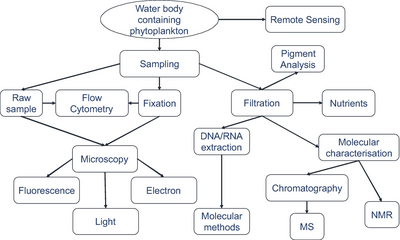
| External videos | |
|---|---|
Methods of identifying microorganisms[282]
| |||
|---|---|---|---|
| Microscopy techniques |
Molecular techniques | ||
Traditional media
|
API – BBL Crystal – Vitek – Biolog |
WGS
MALDI-TOF MS | |
Recent developments in
The new sequencing technologies and the accumulation of sequence data have resulted in a paradigm shift, highlighted both the ubiquity of microbial communities in association within higher organisms and the critical roles of microbes in ecosystem health.[283] These new possibilities have revolutionized microbial ecology, because the analysis of genomes and metagenomes in a high-throughput manner provides efficient methods for addressing the functional potential of individual microorganisms as well as of whole communities in their natural habitats.[284][285][286]
Using omics data
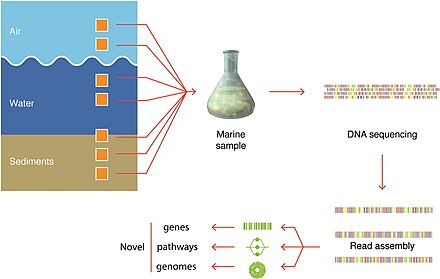
Omics is a term used informally to refer to branches of biology whose names end in the suffix -omics, such as genomics, proteomics, metabolomics, and glycomics. Marine Omics has recently emerged as a field of research of its own.[288] Omics aims at collectively characterising and quantifying pools of biological molecules that translate into the structure, function, and dynamics of an organism or organisms. For example, functional genomics aims at identifying the functions of as many genes as possible of a given organism. It combines different -omics techniques such as transcriptomics and proteomics with saturated mutant collections.[289][290]
Many omes beyond the original
Any given omics technique, used just by itself, cannot adequately disentangle the intricacies of a host
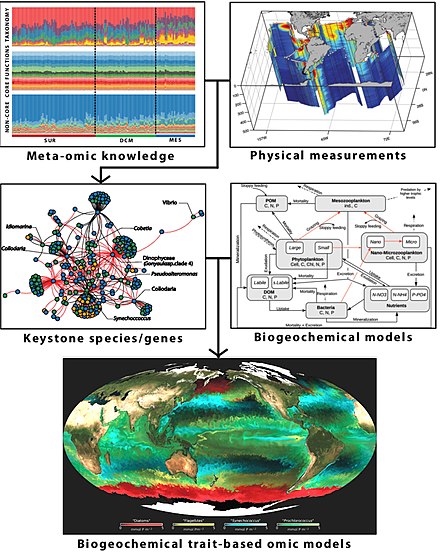
See...
- Brüwer, J.D. and Buck-Wiese, H. (2018) "Reading the Book of Life–Omics as a Universal Tool Across Disciplines". In: YOUMARES 8 – Oceans Across Boundaries: Learning from each other, pages 73–82. Springer. ISBN 9783319932842.
Anthropogenic impacts
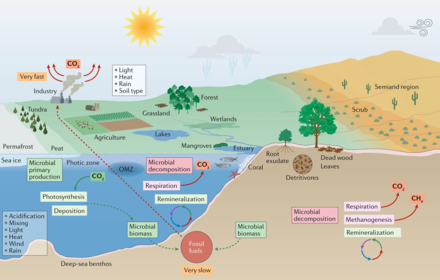
In marine environments, microbial primary production contributes substantially to CO2 sequestration. Marine microorganisms also recycle nutrients for use in the marine food web and in the process release CO2 to the atmosphere. Microbial biomass and other organic matter (remnants of plants and animals) are converted to fossil fuels over millions of years. By contrast, burning of fossil fuels liberates greenhouse gases in a small fraction of that time. As a result, the carbon cycle is out of balance, and atmospheric CO2 levels will continue to rise as long as fossil fuels continue to be burnt.[6]
Microorganisms have key roles in carbon and nutrient cycling, animal (including human) and plant health, agriculture and the global food web. Microorganisms live in all environments on Earth that are occupied by macroscopic organisms, and they are the sole life forms in other environments, such as the deep subsurface and ‘extreme’ environments. Microorganisms date back to the origin of life on Earth at least 3.8 billion years ago, and they will likely exist well beyond any future extinction events... Unless we appreciate the importance of microbial processes, we fundamentally limit our understanding of Earth's biosphere and response to climate change and thus jeopardize efforts to create an environmentally sustainable future.[6]
History
Marine microorganisms known as cyanobacteria first emerged in the oceans during the Precambrian era roughly 2 billion years ago. Over eons, the photosynthesis of marine microorganisms generated by oxygen has helped shape the chemical environment in the evolution of plants, animals and many other life forms. Marine microorganisms were first observed in 1675 by Dutch lensmaker Antonie van Leeuwenhoek.
See also
- Marine life
- Deep chlorophyll maximum
- Hawaii Ocean Time-series
- International Census of Marine Microbes
- Marine microbial symbiosis
- Microbial biogeography
- Microbial communities
- Microbial ecology
- Microbial food web
- Microbial loop
- Microbial oxidation of sulfur
- Sulfate-reducing microorganisms
- Microbially induced sedimentary structure
- Microbiology of oxygen minimum zones
- Oceanic carbon cycle
- Ooid
- Picoeukaryote
- Roseobacter
References
- ^ ISBN 978-0-321-73551-5.
- ^ ISSN 0038-2353.
- ^ PMID 13481308.
- ^ PMID 29784790.
- ^ Census Of Marine Life Accessed 29 October 2020.
- ^ PMID 31213707..
 Modified text was copied from this source, which is available under a Creative Commons Attribution 4.0 International License
Modified text was copied from this source, which is available under a Creative Commons Attribution 4.0 International License - ISBN 9783319330006
- ^ a b "Functions of global ocean microbiome key to understanding environmental changes". www.sciencedaily.com. University of Georgia. 10 December 2015. Retrieved 11 December 2015.
- ^ a b 2002 WHO mortality data Accessed 20 January 2007
- New York Times. Retrieved 25 July 2016.
- S2CID 4370363.
- ^ ISBN 978-2-918428-71-8
- S2CID 4370363.
- ^ Shors p. 5.[full citation needed]
- ^ Shors p. 593.[full citation needed]
- ^ S2CID 4658457.
- ^ Living Bacteria Are Riding Earth's Air Currents Smithsonian Magazine, 11 January 2016.
- ^ Robbins, Jim (13 April 2018). "Trillions Upon Trillions of Viruses Fall From the Sky Each Day". The New York Times. Retrieved 14 April 2018.
- PMID 29379178.
- ^ Staff (2014). "The Biosphere". Aspen Global Change Institute. Archived from the original on 2 September 2010. Retrieved 10 November 2014.
- ^ LiveScience. Retrieved 17 March 2013.
- doi:10.1038/ngeo1773.
- LiveScience. Retrieved 17 March 2013.
- ^ Morelle, Rebecca (15 December 2014). "Microbes discovered by deepest marine drill analysed". BBC News. Retrieved 15 December 2014.
- PMID 18664583.
- PMID 25143097.
- ^ Mack, Eric (20 August 2014). "Life Confirmed Under Antarctic Ice; Is Space Next?". Forbes. Retrieved 21 August 2014.
- S2CID 36480105.
- S2CID 10055219.
- PMID 29057790.
- PMID 16984643.
- ^ PMID 12941415.
- ^ a b Rybicki EP (1990). "The classification of organisms at the edge of life, or problems with virus systematics". South African Journal of Science. 86: 182–186.
- ^ PMID 26965225.
- PMID 16494962.
- PMID 20660197.
- ISBN 978-0-12-375146-1.
- ^ PMID 15884981.
- PMID 10704475.
- ^ S2CID 4370363.
- S2CID 4271861.
- S2CID 52829633.
- PMID 23635867.
- PMID 17634101.
- PMID 22020507.
- PMID 22808158.
- S2CID 4462007.
- ^ "Scientists Find New Type of Virus in World's Oceans: Autolykiviridae". Sci News. 25 January 2018.
- ^ Dockrill, Peter (25 January 2018). "Never-Before-Seen Viruses With Weird DNA Were Just Discovered in The Ocean". Sciencealert.
- PMID 32761142.
- PMID 19158076.
- S2CID 9915859.
- S2CID 20018642.
- ^ "Harmful Algal Blooms: Red Tide: Home | CDC HSB". www.cdc.gov. Retrieved 19 December 2014.
- PMID 11536914.
- PMID 29487281.
- S2CID 89815981.
- ^ Bichell, Rae Ellen. "In Giant Virus Genes, Hints About Their Mysterious Origin". All Things Considered.
- .
- PMID 22482024.
- S2CID 206655792.
- PMID 30837339.
- PMID 15240306.
- PMID 2112744.
- PMID 8041691.
- PMID 12116647.
- PMID 9409149.
- S2CID 19424594.
- S2CID 36026766.
- PMID 10690412.
- PMID 10607659.
- S2CID 17522125.
- ^ "Candidatus Pelagibacter Ubique". Bacteria Genomes. European Bioinformatics Institute. 2011. Archived from the original on 1 December 2008. Retrieved 8 January 2012.
- ^ "Flea market: A newly discovered virus may be the most abundant organism on the planet". The Economist. 16 February 2013. Retrieved 16 February 2013.
- S2CID 4348619.
- ^ "The largest Bacterium: Scientist discovers new bacterial life form off the African coast", Max Planck Institute for Marine Microbiology, 8 April 1999, archived from the original on 20 January 2010
- ^ List of Prokaryotic names with Standing in Nomenclature – Genus Thiomargarita
- PMID 25907112.
- ^ Archaea Online Etymology Dictionary. Retrieved 17 August 2016.
- S2CID 4431143.
- PMID 7287626.
- ISBN 978-0-13-144329-7.
- ^ "Deep sea microorganisms and the origin of the eukaryotic cell" (PDF). Retrieved 24 October 2017.
- PMID 23024290.
- PMID 418827.
- PMID 30643201.
- ^ PMID 28768886.
- PMID 26588818.
- PMID 8302218.
- PMID 1292654.
- PMID 16191619.
- PMID 11755083.
- ^ a b Andrew Alverson (14 October 2022). "The Air You're Breathing? A Diatom Made That". LiveScience.
- ^ "More on Diatoms". University of California Museum of Paleontology. Archived from the original on 4 October 2012. Retrieved 11 October 2019.
- PMID 2672337.
- S2CID 8819675. Archived from the original(PDF) on 16 December 2008.
- .
- ISBN 9780805375039
- S2CID 85406712.
- S2CID 8060916.
- ISBN 9780080920146.
- ^ PMID 23312067.
- ^ S2CID 91380765.
- ISBN 978-0-470-03545-0.
- ^ David J. Patterson. "Amoebae: Protists Which Move and Feed Using Pseudopodia". Tree of Life web project.
- ^ "The Amoebae". The University of Edinburgh. Archived from the original on 10 June 2009.
- PMID 7684268.
- S2CID 3932471.
- S2CID 22264931.
- ^ Kirk, P.M., Cannon, P.F., Minter, D.W. and Stalpers, J. "Dictionary of the Fungi". Edn 10. CABI, 2008
- S2CID 84879817.
- PMID 19633124.
- .
- ^ Jones, E.B.G., Hyde, K.D., & Pang, K.-L., eds. (2014). Freshwater fungi: and fungal-like organisms. Berlin/Boston: De Gruyter.
- ISBN 978-3-11-026406-7. Retrieved 3 September 2015.
- PMID 24992154.
- S2CID 39378040. Retrieved 3 September 2015.
- S2CID 21288251.
- PMID 12756301.
- ^ PMID 19641535.
- PMID 26226014.
- ISSN 0717-6538.
- ^ a b Sridhar, K.R. (2009). "10. Aquatic fungi – Are they planktonic?". Plankton Dynamics of Indian Waters. Jaipur, India: Pratiksha Publications. pp. 133–148.
- ^ "Species of Higher Marine Fungi". Marine Fungi. University of Southern Mississippi. Archived from the original on 22 April 2013. Retrieved 5 February 2012.
- ^ Hawksworth, D.L. (2000). "Freshwater and marine lichen-forming fungi" (PDF). Fungal Diversity. 5: 1–7. Retrieved 6 February 2012.
- ^ "Lichens". National Park Service, US Department of the Interior, Government of the United States. 22 May 2016. Retrieved 4 April 2018.
- ^ a b "The Earth Life Web, Growth and Development in Lichens". earthlife.net. 14 February 2020.
- PMID 14657360.
- S2CID 27083645.
- ISBN 9783110264067.
- S2CID 4340458.
- ^ "Briny deep basin may be home to animals thriving without oxygen". Science News. 23 September 2013.
- ^ ISBN 978-0-321-54325-7.
- ^ McNeill, J.; et al., eds. (2012). International Code of Nomenclature for algae, fungi, and plants (Melbourne Code), Adopted by the Eighteenth International Botanical Congress Melbourne, Australia, July 2011 (electronic ed.). International Association for Plant Taxonomy. Retrieved 14 May 2017.
- ^ Changes in oxygen concentrations in our ocean can disrupt fundamental biological cycles Phys.org, 25 November 2019.
- ISBN 978-0-08-087782-2.
- ^ "The Rise of Oxygen". Astrobiology Magazine. 30 July 2003. Archived from the original on 3 April 2015. Retrieved 6 April 2016.
- S2CID 53618061.
- ^ Rothschild, Lynn (September 2003). "Understand the evolutionary mechanisms and environmental limits of life". NASA. Archived from the original on 29 March 2012. Retrieved 13 July 2009.
- PMID 14631732. Archived from the original(PDF) on 19 April 2014. Retrieved 2 June 2019.
- ^ Joe Palca (12 June 2008). "The Most Important Microbe You've Never Heard Of". npr.org.
- PMID 23703908.
- ISBN 978-0-8053-4416-5.
- ^ Allaby, M., ed. (1992). "Algae". The Concise Dictionary of Botany. Oxford: Oxford University Press.
- S2CID 30911529.
- ^ a b Guiry, M.D.; Guiry, G.M. (2016). "Algaebase". www.algaebase.org. Retrieved 20 November 2016.
- ISBN 978-0-565-09175-0.
- OCLC 443576944.
- ^ Starckx, Senne (31 October 2012). "A place in the sun". Flanders Today. Archived from the original on 4 March 2016. Retrieved 8 December 2012.
Algae is the crop of the future, according to researchers in Geel
- S2CID 6241264.
- ^ Pierre Madl; Maricela Yip (2004). "Literature Review of Caulerpa taxifolia". BUFUS-Info. 19 (31). Archived from the original on 8 October 2022. Retrieved 11 October 2019.
- PMID 11539474.
- ISBN 0-7506-3384-0.
- ^ Eerie red glow traces ocean plant health NASA Science, 28 May 2009.
- hdl:1912/2854.
- ^ a b Wassilieff, Maggy (2006) "Plankton – Plant plankton", Te Ara – the Encyclopedia of New Zealand. Accessed: 2 November 2019.
- ^ Lindsey, R., Scott, M. and Simmon, R. (2010) "What are phytoplankton". NASA Earth Observatory.
- PMID 9657713.
- S2CID 5672525.
- ^ "King's College London – Lake Megachad". www.kcl.ac.uk. Retrieved 5 May 2018.
- PMID 30687251.
- .
- ISBN 9783662062784.
- ^ Wassilieff, Maggy (2006) "A coccolithophore", Te Ara – the Encyclopedia of New Zealand. Accessed: 2 November 2019.
- PMID 20436957. e1000359.
- ^ PMID 31457093.
- PMID 19709178.
- S2CID 1461255.
- American Academy of Microbiology. Archived from the originalon 7 August 2016. Retrieved 2 July 2016.
- ^ Bacteria with Batteries, Popular Science, January 2001, Page 55.
- PMID 10988064.
- PMID 26286928.
- ISBN 978-4-431-55516-2. Retrieved 30 September 2015.
- ^ A tiny marine microbe could play a big role in climate change University of Southern California, Press Room, 8 August 2019.
- S2CID 119341330.
- Bibcode:2006AAS...209.0605S.
- OCLC 13993674.
- ^ S2CID 62781480.
- S2CID 5677709.
- S2CID 42385900.
- S2CID 5432036.
- ^ Stevens, Alison N. P. (2010). "Predation, Herbivory, and Parasitism". Nature Education Knowledge. 3 (10): 36.
- ISBN 978-3-540-38577-6.
- . summarizes findings from many authors.
- ^ a b Wassilieff, Maggy (2006) "Plankton - Animal plankton", Te Ara - the Encyclopedia of New Zealand. Accessed: 2 November 2019.
- PMID 11970318.
- ^ ISBN 978-3-540-96815-3.
- ^ Foraminifera: History of Study, University College London. Retrieved: 18 November 2019.
- ISBN 978-1-4684-7612-5.
- .
- PMID 26627232.
- ^ Richard Collins (14 November 2016). "Beware the mixotrophs – they can destroy entire ecosystems 'in a matter of hours'". Irish Examiner.
- ^ "Microscopic body snatchers infest our oceans". Phys.org. 2 August 2017.
- PMID 17028233.
- S2CID 22837754.
- .
- ^ "Welcome to the Phaeocystis antarctica genome sequencing project homepage".
- S2CID 4409009.
- .
- PMID 23071304.
- PMID 30210473.
- ^ PMID 27483121.
- ^ PMID 26927496.
- .
- S2CID 83885629.
- ^ Suggested Explanation for Glowing Seas--Including Currently Glowing California Seas National Science Foundation, 18 October 2011.
- ISBN 9783319281476.
- ^ Anderson, O. R. (1983). Radiolaria. Springer Science & Business Media.
- PMID 8896371.
- ISBN 978-0071113021.
- PMID 8707056.
- S2CID 3872860.
- The Merck Veterinary Manual. Archived from the originalon 3 March 2016. Retrieved 4 November 2019.
- PMID 36733478.
- .
- PMID 29924811.
- ^ Thomson, Charles Wyville (2014) Voyage of the Challenger : The Atlantic Cambridge University Press, page235.
ISBN 9781108074759.
- ISBN 978-0-08-053441-1. Retrieved 13 November 2013.
- PMID 17661235.
- PMID 21713028.
- ^ ISBN 9780080534961
- SERC, Carleton College. Modified 23 July 2020. Retrieved 10 September 2020.
- ^ Earth barreling toward 'Hothouse' state not seen in 50 million years, epic new climate record shows LiveScience, 10 September 2020.
- S2CID 221593388.
- ^ Bob Yirka (29 August 2013). "Soil beneath ocean found to harbor long lived bacteria, fungi and viruses". Phys.org.
- ^ Ian Sample (2 May 2010). "The oldest living organisms: ancient survivors with a fragile future". The Guardian.
- ^ Joe Hanson. "The oldest living thing in the world". It's Okay to be Smart. Archived from the original on 13 July 2018. Retrieved 13 July 2018.
- PMID 17728401.
- doi:10.3389/fmicb.2020.01150..
 Modified text was copied from this source, which is available under a Creative Commons Attribution 4.0 International License
Modified text was copied from this source, which is available under a Creative Commons Attribution 4.0 International License - ISBN 9780262132695.
- PMID 26284777.
- doi:10.1128/mSystems.00028-16..
 Modified text was copied from this source, which is available under a Creative Commons Attribution 4.0 International License
Modified text was copied from this source, which is available under a Creative Commons Attribution 4.0 International License - .
- PMID 25655016.
- .
- .
- doi:10.1086/378684.
- PMID 30467310.
- .
- doi:10.1186/s40168-018-0428-1..
 Modified text was copied from this source, which is available under a Creative Commons Attribution 4.0 International License
Modified text was copied from this source, which is available under a Creative Commons Attribution 4.0 International License - doi:10.3390/microorganisms5040081..
 Modified text was copied from this source, which is available under a Creative Commons Attribution 4.0 International License
Modified text was copied from this source, which is available under a Creative Commons Attribution 4.0 International License - doi:10.1186/s12864-018-5064-4..
 Modified text was copied from this source, which is available under a Creative Commons Attribution 4.0 International License
Modified text was copied from this source, which is available under a Creative Commons Attribution 4.0 International License - JSTOR 1313569.
- PMID 17298376.
- ^ Robinson, Carol, and Nagappa Ramaiah. "Microbial heterotrophic metabolic rates constrain the microbial carbon pump." The American Association for the Advancement of Science, 2011.
- PMID 26914416.
- ^ What is marine snow? NOAA National Ocean Service. Updated:06/25/18.
- doi:10.5194/npg-24-293-2017..
 Modified text was copied from this source, which is available under a Creative Commons Attribution 3.0 International License
Modified text was copied from this source, which is available under a Creative Commons Attribution 3.0 International License - .
- S2CID 20798336.
- ISSN 8755-1209.
- ISSN 1385-1101.
- PMID 22084639.
- PMID 22084639.
- S2CID 4370363.
- S2CID 4658457.
- PMID 25279954.
- ISSN 0967-0637.
- PMID 22457982.
- S2CID 10737747.
- EurekAlert!. Retrieved 11 December 2018.
- ^ Dockrill, Peter (11 December 2018). "Scientists Reveal a Massive Biosphere of Life Hidden Under Earth's Surface". Science Alert. Retrieved 11 December 2018.
- ^ Gabbatiss, Josh (11 December 2018). "Massive 'deep life' study reveals billions of tonnes of microbes living far beneath Earth's surface". The Independent. Retrieved 11 December 2018.
- S2CID 199636268.
- ^ "World's Oldest Groundwater Supports Life Through Water-Rock Chemistry". deepcarbon.net. Deep Carbon Observatory. 29 July 2019. Archived from the original on 10 September 2019.
- ^ Strange life-forms found deep in a mine point to vast 'underground Galapagos', By Corey S. Powell, 7 Sept. 2019, nbcnews.com.
- ^ Oldest Water on Earth Found Deep Within the Canadian Shield, 14 December 2016, Maggie Romuld
- ^ Wu, Katherine J. (28 July 2020). "These Microbes May Have Survived 100 Million Years Beneath the Seafloor – Rescued from their cold, cramped and nutrient-poor homes, the bacteria awoke in the lab and grew". The New York Times. Retrieved 31 July 2020.
- PMID 32724059.
- ^ PMID 16116082.
- Eurekalert!. Retrieved 26 September 2018.
- S2CID 16888890.
- S2CID 34992724.
- PMID 27140646.
- ^ doi:10.3390/d10020046..
 Modified text was copied from this source, which is available under a Creative Commons Attribution 4.0 International License
Modified text was copied from this source, which is available under a Creative Commons Attribution 4.0 International License - ^ PMID 22028628.
- PMID 8282683.
- PMID 2439888.
- ^ a b Collins, R. Eric (2019) The Small and Mighty – Microbial Life NOAA: Ocean Exploration and Research, Gulf of Alaska Seamounts 2019 Expedition.
 This article incorporates text from this source, which is in the public domain.
This article incorporates text from this source, which is in the public domain.
- doi:10.1007/978-3-319-93284-2_5..
 Modified text was copied from this source, which is available under a Creative Commons Attribution 4.0 International License
Modified text was copied from this source, which is available under a Creative Commons Attribution 4.0 International License - PMID 31086084..
 Modified text was copied from this source, which is available under a Creative Commons Attribution 4.0 International License
Modified text was copied from this source, which is available under a Creative Commons Attribution 4.0 International License - .
- .
- .
- doi:10.1186/s40168-020-00875-0..
 Modified text was copied from this source, which is available under a Creative Commons Attribution 4.0 International License
Modified text was copied from this source, which is available under a Creative Commons Attribution 4.0 International License - PMID 26204808..
 Modified text was copied from this source, which is available under a Creative Commons Attribution 4.0 International License
Modified text was copied from this source, which is available under a Creative Commons Attribution 4.0 International License - ^ Giuliano, Laura; Barbier, Michele; Briand, Frederic, eds. (September 2010). Special Issue: Marine Omics. Microbial Biotechnology, Vol. 3, n°5. Wiley-Blackwell. pp. 489–621.
- S2CID 7768096.
- PMID 32533119.
- .
- doi:10.3389/fmars.2019.00623..
 Modified text was copied from this source, which is available under a Creative Commons Attribution 4.0 International License
Modified text was copied from this source, which is available under a Creative Commons Attribution 4.0 International License - .
- .
- .
- .
- .
- doi:10.1111/gcb.12983..
 Modified text was copied from this source, which is available under a Creative Commons Attribution 4.0 International License
Modified text was copied from this source, which is available under a Creative Commons Attribution 4.0 International License - ^ .
- doi:10.1038/ngeo1757.
General references
- Haq B.U. and Boersma A. (Eds.) (1998) Introduction to Marine Micropaleontology Elsevier. ISBN 9780080534961
- Kirchman, David L. (2018) Processes in Microbial Ecology Oxford University Press. ISBN 9780192506474
- Helmreich, Stefan (2009) Alien Ocean: Anthropological Voyages in Microbial Seas University of California Press. ISBN 9780520942608
- Munn, Colin B. (2019) Marine Microbiology: Ecology & Applications CRC Press. ISBN 9780429592362
- Stal LJ and Cretoiu MS (2016) The Marine Microbiome: An Untapped Source of Biodiversity and Biotechnological Potential Springer. ISBN 9783319330006
- Middelboe M and Corina Brussaard CPD (Eds.) Marine Viruses 2016, MDPI.
- Ohtsuka S, Suzaki T, Horiguchi T, Suzuki N and Not F (Eds.) (2015) Marine Protists: Diversity and Dynamics Springer. ISBN 9784431551300
- Johnson MD and V. Moeller HV (2019) Mixotrophy in Protists: From Model Systems to Mathematical Models, 2nd Edition, Frontiers Media. ISBN 9782889631483
- Radiolarian art


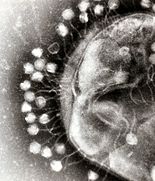
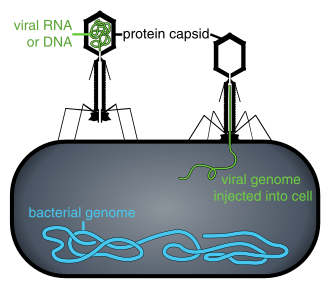
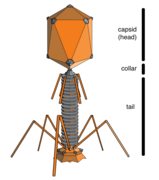

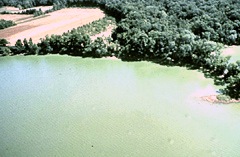
![The chloroplasts of glaucophytes have a peptidoglycan layer, evidence suggesting their endosymbiotic origin from cyanobacteria.[72]](http://upload.wikimedia.org/wikipedia/commons/thumb/c/c9/Glaucocystis_sp.jpg/280px-Glaucocystis_sp.jpg)
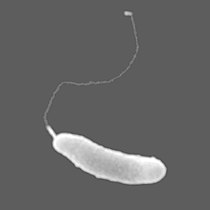


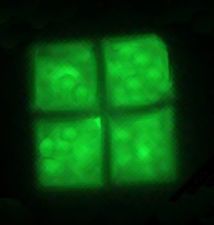

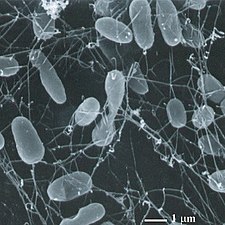
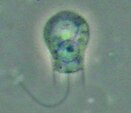

![Diatoms are a major algae group generating about 20% of world oxygen production.[93]](http://upload.wikimedia.org/wikipedia/commons/thumb/3/31/Diatoms_through_the_microscope.jpg/297px-Diatoms_through_the_microscope.jpg)
![Diatoms have glass like cell walls made of silica and called frustules.[94]](http://upload.wikimedia.org/wikipedia/commons/thumb/9/90/Diatom_algae_Amphora_sp.jpg/260px-Diatom_algae_Amphora_sp.jpg)


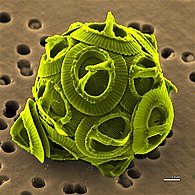
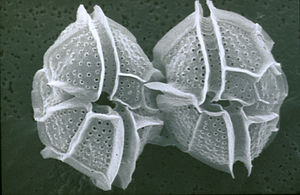
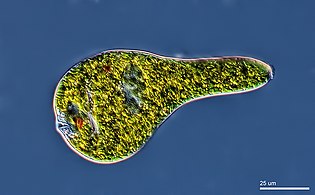
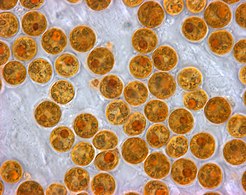
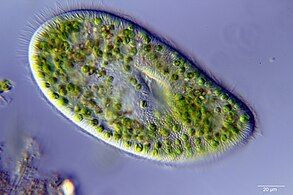
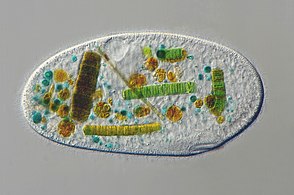
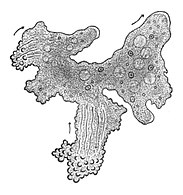
![Gromia sphaerica is a large spherical testate amoeba which makes mud trails. Its diameter is up to 3.8 cm.[96]](http://upload.wikimedia.org/wikipedia/commons/thumb/9/99/Gromia_in_situ_closeup.png/266px-Gromia_in_situ_closeup.png)
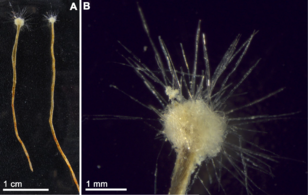
![The xenophyophore, another single-celled foraminiferan, lives in abyssal zones. It has a giant shell up to 20 cm across.[97]](http://upload.wikimedia.org/wikipedia/commons/thumb/5/5d/Xenophyophore.jpg/292px-Xenophyophore.jpg)
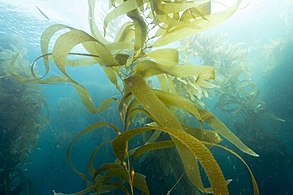

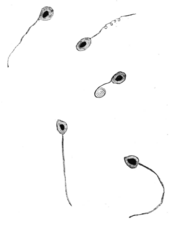

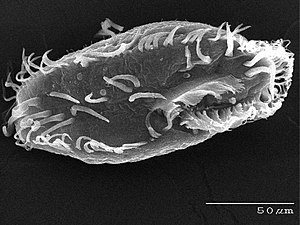
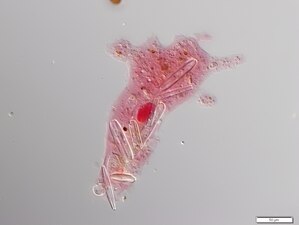



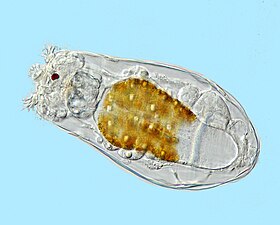

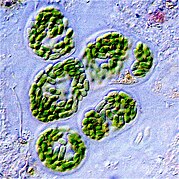
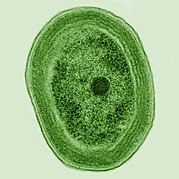
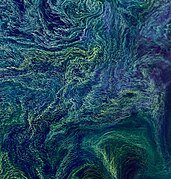

![Chlorella vulgaris, a common green microalgae, in endosymbiosis with a ciliate[152]](http://upload.wikimedia.org/wikipedia/commons/thumb/b/b6/%D0%98%D0%BD%D1%84%D1%83%D0%B7%D0%BE%D1%80%D0%B8%D0%B8_Ophridium_versatile.jpg/338px-%D0%98%D0%BD%D1%84%D1%83%D0%B7%D0%BE%D1%80%D0%B8%D0%B8_Ophridium_versatile.jpg)
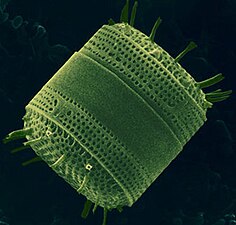

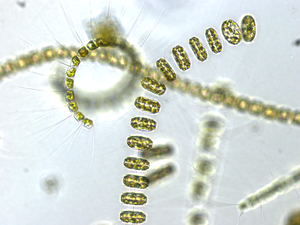
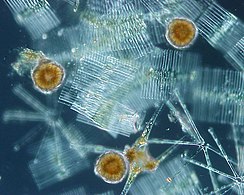

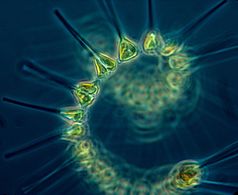
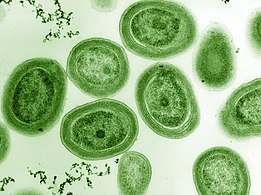
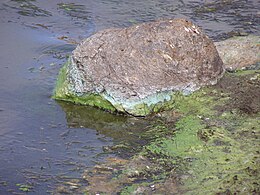
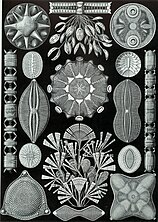
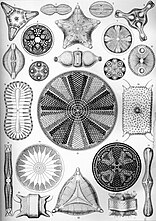

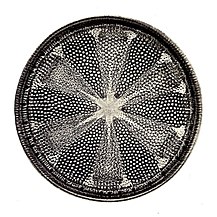


![Guinardia delicatula, a diatom responsible for algal blooms in the North Sea and the English Channel[161]](http://upload.wikimedia.org/wikipedia/commons/thumb/4/43/Fjouenne_sbrmvr012w_20070924163039_small.jpg/260px-Fjouenne_sbrmvr012w_20070924163039_small.jpg)
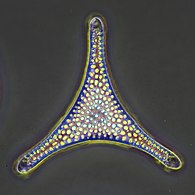

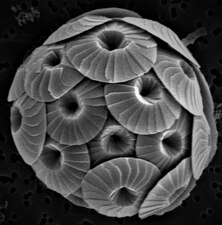
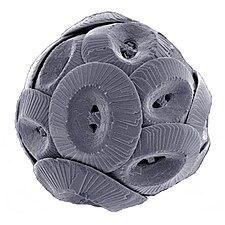

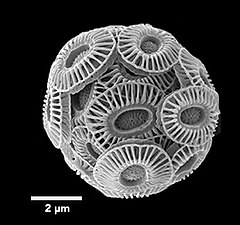
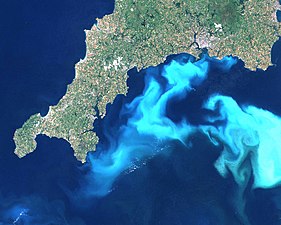

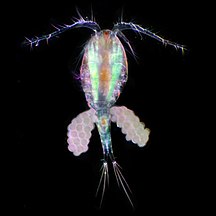

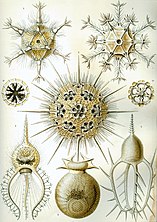
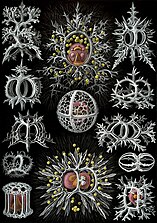
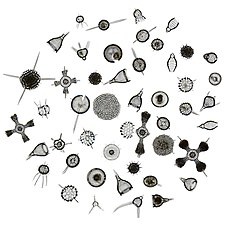


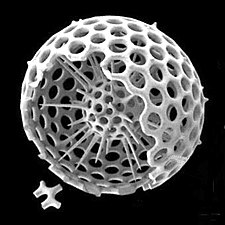
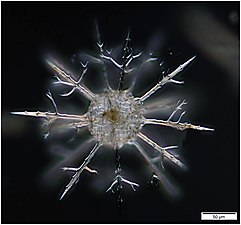
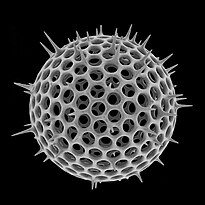
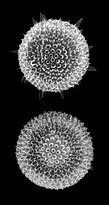
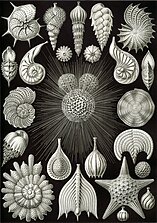
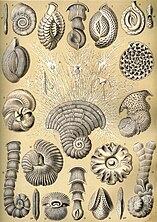
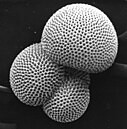


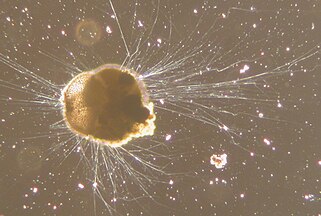
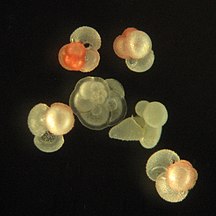

![The Egyptian pyramids were constructed from limestone that contained nummulites.[188]](http://upload.wikimedia.org/wikipedia/commons/thumb/a/af/All_Gizah_Pyramids.jpg/325px-All_Gizah_Pyramids.jpg)
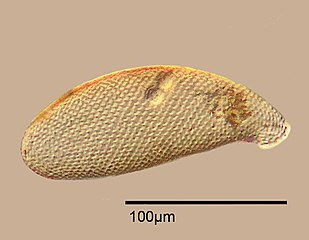
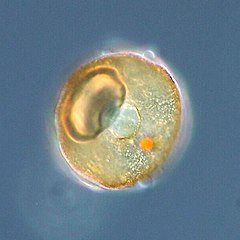
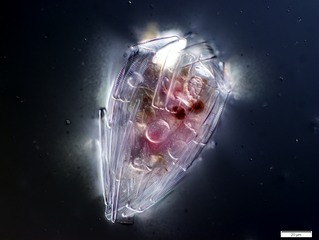

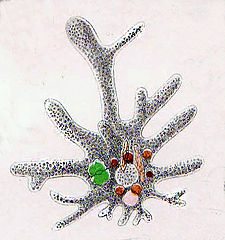
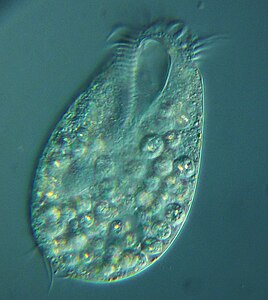


![Mesodinium rubrum produce deep red blooms using enslaved chloroplasts from their algal prey [191]](http://upload.wikimedia.org/wikipedia/commons/thumb/d/df/Mesodinium_rubrum.jpg/300px-Mesodinium_rubrum.jpg)
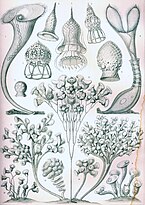
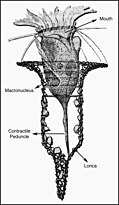
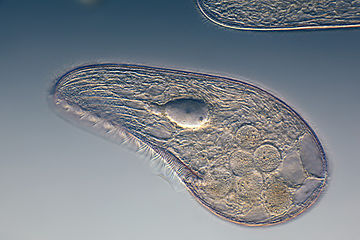



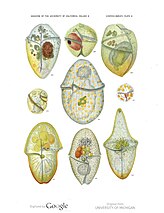





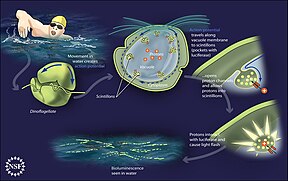



![Oodinium, a genus of parasitic dinoflagellates, causes velvet disease in fish[213]](http://upload.wikimedia.org/wikipedia/commons/thumb/8/87/Archives_de_zoologie_exp%C3%A9rimentale_et_g%C3%A9n%C3%A9rale_%281920%29_%2820299351186%29.jpg/260px-Archives_de_zoologie_exp%C3%A9rimentale_et_g%C3%A9n%C3%A9rale_%281920%29_%2820299351186%29.jpg)
![Karenia brevis produces red tides highly toxic to humans[214]](http://upload.wikimedia.org/wikipedia/commons/thumb/a/a0/Karenia_brevis.jpg/214px-Karenia_brevis.jpg)

![Noctiluca scintillans, a bioluminescent dinoflagellate[215]](http://upload.wikimedia.org/wikipedia/commons/thumb/6/62/Noctiluca_scintillans_unica.jpg/196px-Noctiluca_scintillans_unica.jpg)
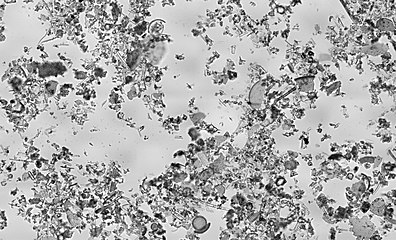

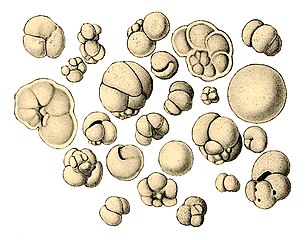

![Marble can contain protist microfossils of foraminiferans, coccolithophores, calcareous nannoplankton and algae, ostracodes, pteropods, calpionellids and bryozoa[222]](http://upload.wikimedia.org/wikipedia/commons/thumb/6/61/MarmoCipollino_FustoBasMassenzioRoma.jpg/320px-MarmoCipollino_FustoBasMassenzioRoma.jpg)
![Opal can contain protist microfossils of diatoms, radiolarians, silicoflagellates and ebridians[222]](http://upload.wikimedia.org/wikipedia/commons/thumb/d/d9/Coober_Pedy_Opal_Doublet.jpg/352px-Coober_Pedy_Opal_Doublet.jpg)




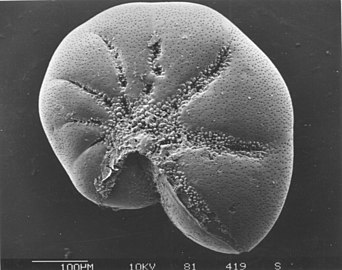

![Coral holobiont[240]](http://upload.wikimedia.org/wikipedia/commons/thumb/2/26/Trophic_connections_of_the_coral_holobiont_in_the_planktonic_food_web.jpg/237px-Trophic_connections_of_the_coral_holobiont_in_the_planktonic_food_web.jpg)
![Sponge holobiont[241]](http://upload.wikimedia.org/wikipedia/commons/thumb/6/6b/The_sponge_holobiont.webp/304px-The_sponge_holobiont.webp.png)
![Seagrass holobiont[242]](http://upload.wikimedia.org/wikipedia/commons/thumb/3/35/Processes_within_the_seagrass_holobiont.webp/197px-Processes_within_the_seagrass_holobiont.webp.png)
![Climate change and the rhodolith holobiont[243]](http://upload.wikimedia.org/wikipedia/commons/thumb/f/f7/Climate_change_stressors_and_rhodolith_holobiont_fitness.webp/415px-Climate_change_stressors_and_rhodolith_holobiont_fitness.webp.png)
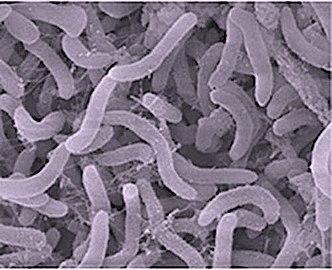
![Marine snow is the shower of organic particles that falls from upper waters to the deep ocean[248] It is a major exporter of carbon.](http://upload.wikimedia.org/wikipedia/commons/thumb/5/59/Marine_snow.jpg/270px-Marine_snow.jpg)
![Estimates of microbial species counts in the three domains of life Bacteria are the oldest and most biodiverse group, followed by Archaea and Fungi (the most recent groups). In 1998, before awareness of the extent of microbial life had gotten underway, Robert M. May[274] estimated there were 3 million species of living organisms on the planet. But in 2016, Locey and Lennon[275] estimated the number of microorganism species could be as high as 1 trillion.[276]](http://upload.wikimedia.org/wikipedia/commons/thumb/b/bc/Microbial_species_present_in_the_three_domains_of_life.png/889px-Microbial_species_present_in_the_three_domains_of_life.png)
![Microbial diversity Comparative representation of the known and estimated (small box) and the yet unknown (large box) microbial diversity, which applies to both marine and terrestrial microorganisms. The text boxes refer to factors that adversely affect the knowledge of the microbial diversity that exists on the planet.[276]](http://upload.wikimedia.org/wikipedia/commons/thumb/1/16/Known%2C_estimated_and_unknown_microbial_diversity.webp/661px-Known%2C_estimated_and_unknown_microbial_diversity.webp.png)
